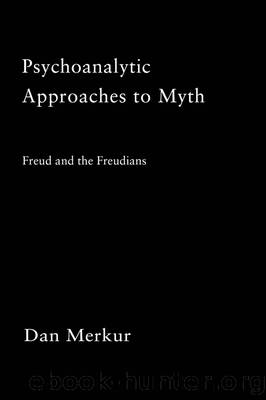Psychoanalytic Approaches to Myth by Merkur Daniel

Author:Merkur, Daniel.
Language: eng
Format: epub
Publisher: Taylor & Francis (CAM)
Each of these refrains was repeated forty or so times, functionally providing a text that guided the patient through meditations. The chants assumed that the patient was possessed by Coyote and they guided the patient to imagine himself seeking, finding, and reabsorbing his own identity. The return of the patientâs identity on the eighth evening accounted for the already-completed exteriorization of the blue fox at the commencement of the three-dancer mime the next morning.
The summation ceremony of the ninth night involved basket-drum chanting and a ceremony in which yucca leaves were burnt to ashes and suspended in water that the patient was given to drink (Luckert 1979). The symbolism associated yucca with the consecrated fires of the sweat baths of the misfortune part. The symbolism probably alluded to the cactusâs association with Talking-God (Sapir and Hoijer 1942), who functioned as an exorcist in the final mime of the blessing part.
The misfortune part of Coyoteway reinduced both ritual and ecstatic transformation of the patient into Coyote. The blessing part then reversed these effects. Coyoteway implicitly presupposed that ordinary sweat lodge rites on the hunterâs return from the hunt had failed because error had been made in the initial rites at the huntâs beginning. Ritual control of ecstatic possession had therefore to be recommenced at its beginning, when control had first been lost. The reconciliation with Coyote that Coyoteway accomplished involves no more than a re-education, a rite of renewed initiation, into the proper ritual devotion that Coyote required.
From a psychoanalytic point of view, the patient was guided by means of symbolic rituals, sweat baths, continence, various dietary abstinences, perhaps psychoactive medicines, and meditations on chants to experience religious ecstasy of extremely detailed content. There was shrewd heterosuggestive manipulation by which the Chanter aided the one sung over to attain specific insights. The misfortune part provided the insight that Coyote transformation was ritually and hence artificially induced, whereas the blessing part showed it to be entirely temporary in significance. Simultaneous to these insights into the origin of the affliction, the exorcism of Coyote through the chants of the blessing part provided symbolism for displacing the neurosis-causing guilt, by directing the aggression outward at Coyote. The symbolism asserted that Coyote, and not the patient, was responsible for killing. The patient then forgave himself a guilt that was not properly his.
In the final three-dancer mime, the patient was taken the necessary step farther. His aggression against Coyote was an impiety that had been encouraged temporarily to relieve the symptoms of Coyote transformation. The underlying conflict of aggression and piety in the patientâs attitude to Coyote was now addressed with a crucial interpretation. Coyote was revealed as a composite figure, consisting of the coyote-skin coat (ritually, the stuffed blue fox) and Blue Coyote Carrier. Aggression toward the coat was not impiety toward the god. Because Coyote was a âtransferential figureâ (Arlow in Grossman 1993, 760), this feature of the rite constituted an interpretation of the transference, in the technical sense of the term. The presence
Download
This site does not store any files on its server. We only index and link to content provided by other sites. Please contact the content providers to delete copyright contents if any and email us, we'll remove relevant links or contents immediately.
| Administration & Medicine Economics | Allied Health Professions |
| Basic Sciences | Dentistry |
| History | Medical Informatics |
| Medicine | Nursing |
| Pharmacology | Psychology |
| Research | Veterinary Medicine |
Bioenergetica by Alexander Lowen(1428)
The Child in You by Stefanie Stahl(1204)
No Bad Parts by Richard C. Schwartz(1177)
Noise: A Flaw in Human Judgment by Sunstein Cass R. & Sibony Olivier & Kahneman Daniel(1156)
The Data Detective by Tim Harford(1102)
Chatter by Ethan Kross(1026)
The Science of Rapid Skill Acquisition by Peter Hollins(870)
The Quantum Psychiatrist: From Zero to Zen Using Evidence-Based Solutions Beyond Medication and Therapy by Biswas Dona(833)
Freedom by Sebastian Junger(816)
The Montessori Baby by Simone Davies(791)
Maps of Meaning: The Architecture of Belief by Jordan B. Peterson(708)
The Science of Self-Learning: How to Teach Yourself Anything, Learn More in Less Time, and Direct Your Own Education (Learning how to Learn Book 1) by Peter Hollins(690)
Evolution Gone Wrong: The Curious Reasons Why Our Bodies Work by Alex Bezzerides(672)
Sadomasochism and the BDSM Community in the United States by Stephen K. Stein(656)
Anxiety For Dummies by Charles H. Elliott & Laura L. Smith(636)
Why Sex Doesn't Matter by Olivia Fane(629)
Disconnected by thomas Kersting(621)
Jung - The Key Ideas: Teach Yourself (TY Philosophy) by Ruth Snowden(596)
The Mechanics of Passions: Brain, Behaviour, and Society by Alain Ehrenberg(593)
